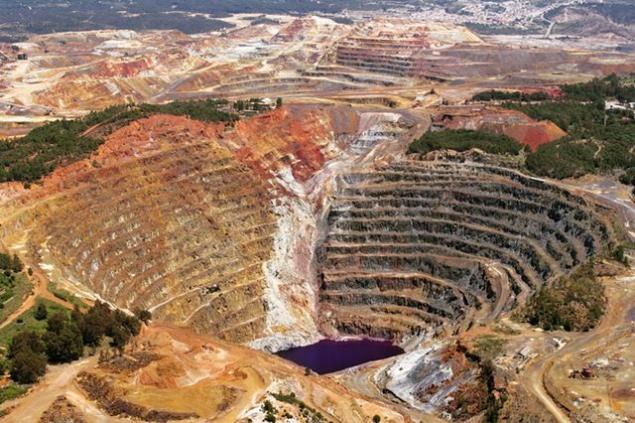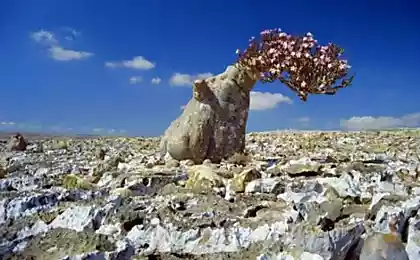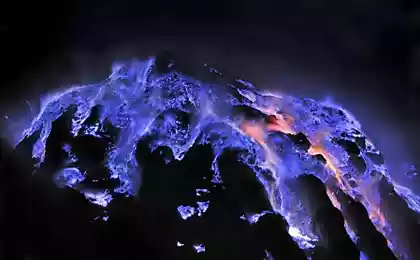3102
Spanish River Rio Tinto
Rio Tinto - a river in south-western part of Spain, which originates in the mountains of Andalusia. Since a long time the land along the river was used for the extraction of copper, silver, gold and other minerals. As a result a lot of mines and quarries bizarre and river water stained in dark red and filled with heavy metals and acid

Rio Tinto (Rio Tinto) is known for its rich acid water (pH 1.7-2.5 factor) and a variety of heavy metals. More than 5,000 years of mining contributed to the contamination of the river, turning Tinto in an extremely dangerous place. Peak production fell to 1930, after which production declined. Copper mine stopped here in 1986, and silver and gold in 1996, but huge mines, quarries and seizure remained, and metals continue to fall into the river.

The river is born a lot of iron-oxidizing bacteria and sulfur and that their activity has caused such a deep color of water. Rio Tinto is home to thousands of other amazing bacteria and organisms.

The river was of great scientific interest because of the activity of aerobic bacteria extremophile, rapidly proliferating in the water. It is these forms of life are considered to be the probable cause of the high content of acid. Feed on bacteria and iron minerals that are washed out of the mines and in large quantities contained in the surface rocks along the river.

This unusual condition of the river caused a large-scale study conducted astrobiology. According to them, the river of the same type may be in other solar systems, for example in the depths of Mars. For example, the moon of Jupiter - Europe probably is oxidized ocean water hidden beneath its icy surface and containing the same bacteria that Rio Tinto in Andalusia.

Based in part on research done by the river Rio Tinto, two scientists from NASA in February 2005 said that they found strong evidence of life on Mars. However, NASA officials have denied the statements of his subordinates, and one of the scientists later retracted his statements.

The biggest and most well-known the local quarry - Corta Atalaya:

But the Red Lake, formed at the bottom of one of the quarries:

Interestingly, these bacteria have been found not only in Rio Tinto, but also under the glaciers of the Dry Valleys, Antarctica on. And here they also caused a keen interest in NASA since Valley area is very similar to the surface of Mars

Another colored river - Cano Cristales in Colombia, but in contrast to Rio Tinto, here worked very different bacteria

Source: p-i-f.livejournal.com

Rio Tinto (Rio Tinto) is known for its rich acid water (pH 1.7-2.5 factor) and a variety of heavy metals. More than 5,000 years of mining contributed to the contamination of the river, turning Tinto in an extremely dangerous place. Peak production fell to 1930, after which production declined. Copper mine stopped here in 1986, and silver and gold in 1996, but huge mines, quarries and seizure remained, and metals continue to fall into the river.

The river is born a lot of iron-oxidizing bacteria and sulfur and that their activity has caused such a deep color of water. Rio Tinto is home to thousands of other amazing bacteria and organisms.

The river was of great scientific interest because of the activity of aerobic bacteria extremophile, rapidly proliferating in the water. It is these forms of life are considered to be the probable cause of the high content of acid. Feed on bacteria and iron minerals that are washed out of the mines and in large quantities contained in the surface rocks along the river.

This unusual condition of the river caused a large-scale study conducted astrobiology. According to them, the river of the same type may be in other solar systems, for example in the depths of Mars. For example, the moon of Jupiter - Europe probably is oxidized ocean water hidden beneath its icy surface and containing the same bacteria that Rio Tinto in Andalusia.

Based in part on research done by the river Rio Tinto, two scientists from NASA in February 2005 said that they found strong evidence of life on Mars. However, NASA officials have denied the statements of his subordinates, and one of the scientists later retracted his statements.

The biggest and most well-known the local quarry - Corta Atalaya:

But the Red Lake, formed at the bottom of one of the quarries:

Interestingly, these bacteria have been found not only in Rio Tinto, but also under the glaciers of the Dry Valleys, Antarctica on. And here they also caused a keen interest in NASA since Valley area is very similar to the surface of Mars

Another colored river - Cano Cristales in Colombia, but in contrast to Rio Tinto, here worked very different bacteria

Source: p-i-f.livejournal.com























